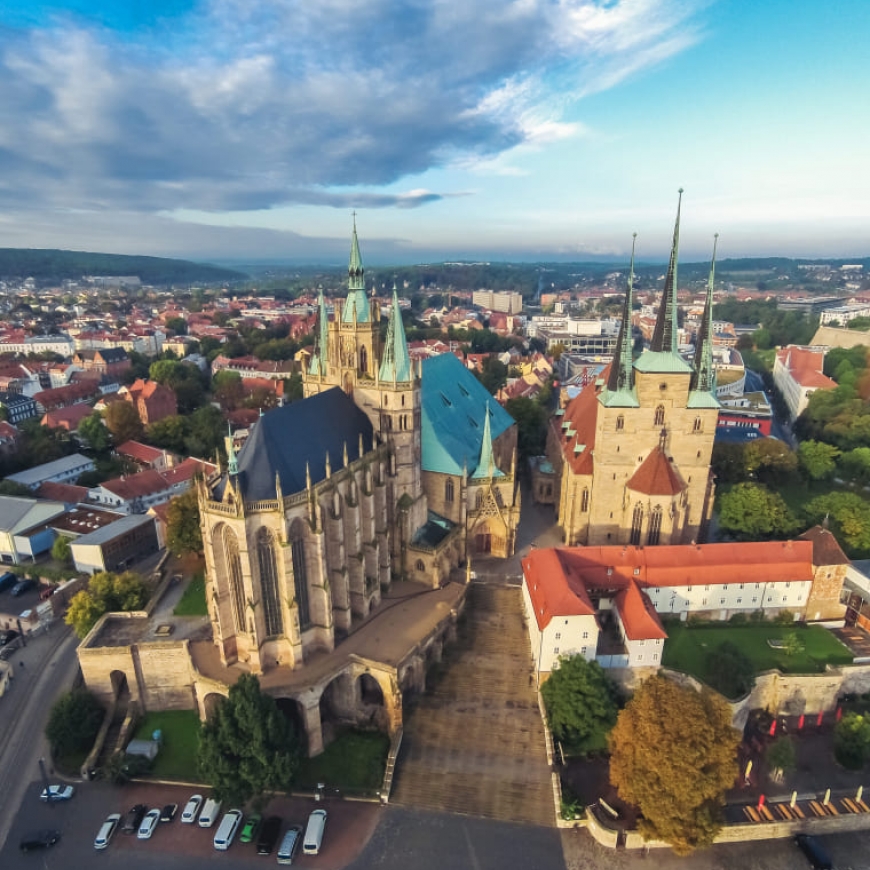Erfurt

Erfurt is the capital and largest city of Thuringia in central Germany. It is located in the south of the Thuringian Basin, north of the Thuringian Forest, and in the wide valley of the Gera River. The city is centrally positioned among the six largest cities of Thuringia.
The Old Town of Erfurt is one of the best-preserved medieval centers in Germany. Notable attractions include the Krämerbrücke (Merchants' Bridge), the Alte Synagoge (Old Synagogue), and the Erfurter Dom and Severikirche churches, as well as the Petersberg Citadel, one of the largest and best-preserved urban fortresses in Central Europe.
Erfurt is located on Via Regia, a medieval trade and pilgrimage route. It was first mentioned under the name "Erphesfurt" in 742 when Saint Boniface founded a parish here. Politically, Erfurt was not part of Thuringia but soon became the economic center of the region and a member of the Hanseatic League. The University of Erfurt, founded in 1379, was the first university established in what is now modern Germany.
During the Middle Ages, it became an important trading city due to its location near a ford over the Gera River. Along with Gotha, Tennstedt, Arnstadt, and Langensalza, it was a center of German trade. In the 15th century, Erfurt reached its economic peak, with a population of 20,000, making it one of Germany's largest cities at the time. Between 1432 and 1446, the tallest city wall was built, and in 1483, the first city fortress was constructed on the Cyriaksburg hill.
In the late 18th century, Erfurt experienced a cultural renaissance under Governor Karl Theodor Anton Maria von Dalberg, who had close relations with Johann Wolfgang von Goethe, Friedrich Schiller, Johann Gottfried Herder, Christoph Martin Wieland, and Wilhelm von Humboldt. They often visited him at the court in Erfurt.
The Industrial Revolution came to Erfurt in the 1840s with the construction of the Thuringian Railway, connecting Berlin and Frankfurt. Many factories were established, including the "Royal Prussian Rifle Factory" in 1862. After the unification of Germany in 1871, Erfurt no longer needed medieval fortifications, leading to their demolition in 1873. The demolition of the city's fortifications led to a building boom, as construction was now possible in the area of the former city walls and beyond.
Erfurt is situated in the fertile Thuringian Basin, a plain in the northern part of the city, while the southern part is hilly. The city's urban landscape features a medieval core with narrow, winding streets surrounded by Gründerzeit architecture from 1873 to 1914. Most of the city center is a pedestrian zone. Public green spaces along the Gera River include Stadtpark, Nordpark, and Südpark, with the largest green area being Egapark, a horticultural exhibition park and botanical garden founded in 1961.
Erfurt's economy is based on agriculture, horticulture, and microelectronics. Its central location has made it a logistics hub not only for Germany but for all of Central Europe. The city hosts the second-largest trade fair in East Germany, after Leipzig, and is home to the children's television channel KiKa.
When Thuringia was re-established in 1990, Erfurt became the capital. Since then, many buildings have been renovated, and the infrastructure has been significantly improved. Today, Erfurt is home to numerous small and medium-sized enterprises specializing in electrical engineering, semiconductors, and solar energy. Engine production, food manufacturing, the Braugold brewery, and the Born company, known for Thuringian mustard, remain important industries.
Erfurt is also a hub for the Inter City Express high-speed trains and other transport networks in Germany and Europe. With the ICE network, Erfurt is about 90 minutes from Berlin, two and a half hours from Frankfurt, two hours from Dresden, and 45 minutes from Leipzig.